Professional Models 1/48 XF5U-1 Flying Flapjack
By Allan Wanta
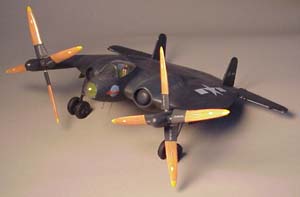 |

 |
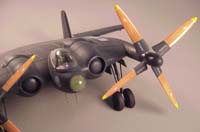 Based on the success of the V-173, the Navy ordered two XF5U-1 prototypes (Bu. Nos. 33958/33959) in 1944. The airframes were completed in August, 1945. An interesting innovation as the use of "metalite" for the skin, a sandwich of balsa between two layers of aluminum. Unfortunately, it wasn't until 1947 that the special articulated propellers were delivered. Tethered tests were performed in Connecticut, but plans to flight test the F5U's at Edwards AFB (delivering them via the Panama Canal) were canceled in 1948, the Navy having lost interest in propeller-driven fighters.
Based on the success of the V-173, the Navy ordered two XF5U-1 prototypes (Bu. Nos. 33958/33959) in 1944. The airframes were completed in August, 1945. An interesting innovation as the use of "metalite" for the skin, a sandwich of balsa between two layers of aluminum. Unfortunately, it wasn't until 1947 that the special articulated propellers were delivered. Tethered tests were performed in Connecticut, but plans to flight test the F5U's at Edwards AFB (delivering them via the Panama Canal) were canceled in 1948, the Navy having lost interest in propeller-driven fighters. The quality of castings are very similar, however fidelity of details become quite evident if you have the Steve Glinter book on the XF5U-1. Professional Models did their homework when trying to depict an detailed and accurate kit, a photo-etched fret handles most of the smaller details, although in a flat two-dimensional sort of way, it does have a great instrument panel.
The quality of castings are very similar, however fidelity of details become quite evident if you have the Steve Glinter book on the XF5U-1. Professional Models did their homework when trying to depict an detailed and accurate kit, a photo-etched fret handles most of the smaller details, although in a flat two-dimensional sort of way, it does have a great instrument panel.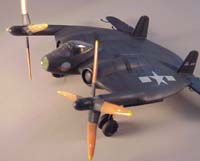 Well, I'll have mine with a whole lot of work in it, namely this kit sat in my maybe finish pile for over a year before it saw the light at the end of the tunnel. Literally, we all have those kits that wait for a 'spurt' of inspiration. Mine couldn't have happened to a nicer kit, if you want a good representation of an XF5U-1. The castings are in typical light tan resin, no air bubbles anywhere, and it looked fairly accurate in dimensions. To be honest, the interior was chucked in the circular file and another scratch-built after the drawing in Steve Glinter's book. It looks an awful lot like a Corsair. Another area of detail, the landing gear, was scratched from aluminum tubing as the resin ones in the kit require too much clean up. The rest of the build was pretty much out of the box.
Well, I'll have mine with a whole lot of work in it, namely this kit sat in my maybe finish pile for over a year before it saw the light at the end of the tunnel. Literally, we all have those kits that wait for a 'spurt' of inspiration. Mine couldn't have happened to a nicer kit, if you want a good representation of an XF5U-1. The castings are in typical light tan resin, no air bubbles anywhere, and it looked fairly accurate in dimensions. To be honest, the interior was chucked in the circular file and another scratch-built after the drawing in Steve Glinter's book. It looks an awful lot like a Corsair. Another area of detail, the landing gear, was scratched from aluminum tubing as the resin ones in the kit require too much clean up. The rest of the build was pretty much out of the box.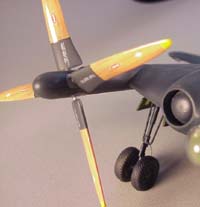 The only new and neat thing that was tried was the Alps decals used for the overall finish of the propellers. A wood grain finish was downloaded into CorelDraw, some triangles and manufacturers markings and yellow tips, with no painting! A lot of Future wax dips and the props looked a whole lot better than any paint job I could ever do. Got to step out on the wild side sometimes guys.
The only new and neat thing that was tried was the Alps decals used for the overall finish of the propellers. A wood grain finish was downloaded into CorelDraw, some triangles and manufacturers markings and yellow tips, with no painting! A lot of Future wax dips and the props looked a whole lot better than any paint job I could ever do. Got to step out on the wild side sometimes guys.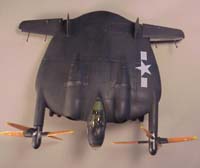 In the end I now have a rare prototype aircraft amongst my rare one-off Luftwaffe aircraft kits - and it fits in just fine, thank you. If you have the chance to get this version of the kit, do so. The Miku version seems O.K., but lacks a lot of detail where it counts. My thanks to Professional Models for making this kit, and here's hoping they re-issue it sometime in the future.
In the end I now have a rare prototype aircraft amongst my rare one-off Luftwaffe aircraft kits - and it fits in just fine, thank you. If you have the chance to get this version of the kit, do so. The Miku version seems O.K., but lacks a lot of detail where it counts. My thanks to Professional Models for making this kit, and here's hoping they re-issue it sometime in the future.